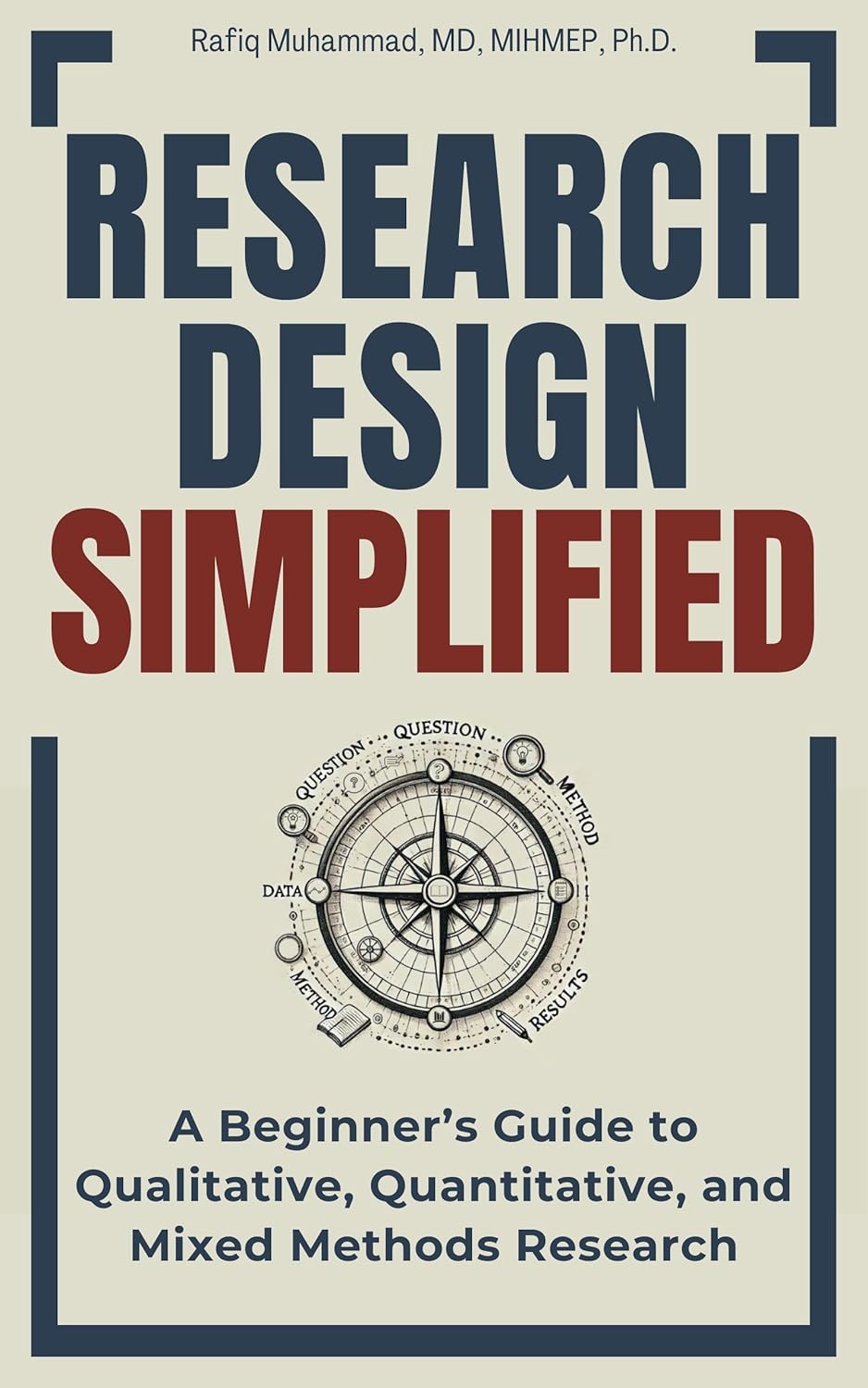Research Design Simplified: A Beginner’s Guide to Qualitative, Quantitative, and Mixed Methods Research
Research Design Simplified gives you a clear research blueprint for selecting research methods that fit your question—whether you need qualitative, quantitative, or mixed methods research. Using a three-question Method Match test, you’ll move from uncertainty to a defensible design in minutes, then refine it with step-by-step templates and mini-cases.
Inside you’ll learn practical strategies for sampling techniques, sample size determination (including quick power-analysis workflows), and how to safeguard validity and reliability (or trustworthiness) from the start. You’ll see exactly when to choose qualitative vs quantitative questions, how to design experimental designs, survey design, case studies and comparative studies, and how to frame hypothesis formulation or exploratory aims that lead to credible causal inference.
- Method Match test: a quick decision tool to align question → design → analysis.
- Study design templates: plug-in outlines for qual, quant, and mixed methods.
- Sampling & sample size: probability and purposive strategies with power-ready tips.
- Validity & reliability: easy checks and research validity tests you can apply immediately.
- Ethics & feasibility: tighten protocols with research ethics prompts and pilot studies.
Whether you’re planning your first study or leveling up your research methodology, this guide replaces guesswork with reproducible decisions—and gives you the language reviewers expect when they ask, “Why this design?”
What’s inside
- Clear chapter-by-chapter roadmap
- Reusable templates and checklists
- Step-by-step examples from real projects
Who it’s for
- Graduate students (MA/MSc/PhD)
- Early-career researchers
- Supervisors seeking practical frameworks
What readers say
“Exactly what I needed to get unstuck.”
“Concise, rigorous, and practical.”
What you'll learn
- 3‑question 'Method Match' test to lock in the right design fast
- Templates for research questions, sampling, validity
- Mini‑cases of real students turning ideas into solid studies
- Checklists to avoid fatal methodological flaws
Frequently asked questions
How do I choose the right research design (qualitative, quantitative, or mixed methods)?
Match design to the nature of your question: explore meanings/process → qualitative; test relationships/causality → quantitative; explain or triangulate complex phenomena → mixed methods. The book’s 3-question “Method Match” test walks you through the decision in minutes.
What’s the difference between qualitative and quantitative research questions?
Qualitative questions ask “how” or “why” about experiences or processes; quantitative questions specify variables and hypothesized relationships you can measure and test. Templates help you rewrite either type for clarity and rigor.
When should I use mixed methods?
Use mixed methods when one strand alone can’t answer the question. Common patterns include convergent (collect qual + quant in parallel) and explanatory sequential (quant first, qual explains results). The book gives step-by-step designs and sample write-ups.
How do I pick a sampling strategy?
For quantitative, use probability methods (simple random, stratified, cluster) to generalize and run stats. For qualitative, use purposive/theoretical sampling to capture information-rich cases. Checklists help you justify size and selection.
How do I determine sample size or run a power analysis?
Quantitative studies should estimate effect sizes and run a priori power analyses (α, power, expected effect). The book includes a quick workflow and free tool suggestions to justify n clearly.
How do I ensure validity and reliability (or trustworthiness) in my design?
Quant: address construct, internal, and external validity plus reliability of instruments. Qual: establish credibility, dependability, confirmability, and transferability via triangulation, audit trails, and member checks. You get checklists for both.
Which data collection methods fit my design?
Quant: surveys, experiments, standardized tests, logs. Qual: interviews, focus groups, observations, documents. Mixed: combine strategically with a clear integration plan (merging, connecting, or embedding).
How do I operationalize variables and choose measures?
Define constructs, map them to observable indicators, select or adapt validated instruments, and pilot test. Templates help you document scales, items, scoring, and evidence of validity.
What analyses pair with each design?
Quant: descriptives → t-tests/ANOVA/χ² → regression/GLMs; Qual: coding → categories → themes/theory (e.g., thematic analysis, grounded theory). Mixed: integrate at design, analysis, and interpretation stages. Mini-cases show end-to-end examples.
How do I write a strong methods section that satisfies reviewers?
State design and rationale, participants/sampling, instruments and procedures, analysis plan, validity/quality safeguards, and limitations. Use the book’s structured template to avoid common gaps.
Do I need ethics/IRB approval and consent language?
If you work with human data, yes. The book provides a pre-IRB checklist (risk, privacy, data security, consent/assent, disclosure) and example language you can adapt.
Can I use AI tools during design without compromising rigor?
Yes—use AI to brainstorm alternatives, refine questions, and draft instrument items, then verify with validated sources and pilot tests. The book includes safe-use guardrails and disclosure tips.
